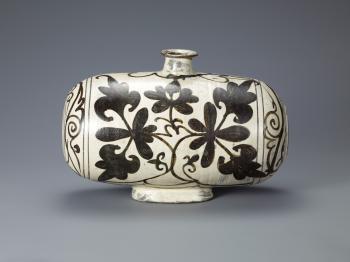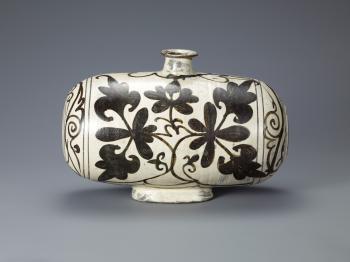NEW YORK—If you have a passion for poetry and Korean Buncheong ceramics, ‘tis time to head over to the Metropolitan Museum of Art to feast your eyes on some of these most exquisite Korean treasures.
Opening on Thursday, April 7, a special exhibition on loan from Leeum, Samsung Museum of Art (LSMA) in Seoul, Korea, “Poetry in Clay: Korean Buncheong Ceramics” will go on view at the Met.
“Poetry in Clay” is the brainchild and collaboration of Soyoung Lee, Met department of Asian Art assistant curator, and Seung-chang Jeon, LSMA’s chief curator.
“We are very pleased to be able to share Leeum, Samsung Museum of Art’s collection with an international audience. We wanted to show the imaginative designs and dynamism of buncheong ceramics, a uniquely Korean genre of art,” said Jeon.
This unique exhibition presents Korean buncheong ware, a bold, dynamic, and free-form ceramic tradition that flourished in Korea during the 15th and 16th centuries of the Joseon dynasty (1392–1910).
Derived from “bunjang hoecheong sagi,” the word “buncheong” was coined in the 20th century. It means gray-green stoneware decorated in white. The unique features of buncheong ware are its distinctive forms of decorative techniques and the use of white slip.
“Buncheong ware has been renowned for its playful simplicity and strikingly abstract designs,” said RaYoung Hong, LSMA deputy director.
While it is a rich embodiment of traditional Korean beauty, buncheong ware retains its strong element of modernity and the dynamism of Korean art, said Hong.
Visitors will be able to appreciate the beauty and the many intricate facets of buncheong ware.
“The exhibition features 65 masterpieces from the LSMA collection in Korea. The majority of the items have never before been seen in the U.S.,” said Hong.
Exhibit highlights include six works officially registered as treasures by the cultural heritage administration of the South Korean government. These include the “Drum-shaped Bottle with Peony Decoration,” the “Large Jar with Inlaid Peony Decoration,” the eye-catching jar “Maebyeong with Dragon Fish Decoration,” and the striking “Jar with Decoration of Fish and Lotuses” with inlay, stamping, sgraffito, and iron-painted design.
It also includes masterpieces by leading contemporary ceramic artists, who have actively recreated Korean buncheong ware in a contemporary context.
“It is a remarkable vision to have been daring enough to both combine the traditional with the modern and contemporary,” said Maxwell Hearn, curator of the Met’s department of Asian art, alluding to the “wonderful directness, simplicity, and a sense of humor” of buncheong ware.
Opening on Thursday, April 7, a special exhibition on loan from Leeum, Samsung Museum of Art (LSMA) in Seoul, Korea, “Poetry in Clay: Korean Buncheong Ceramics” will go on view at the Met.
“Poetry in Clay” is the brainchild and collaboration of Soyoung Lee, Met department of Asian Art assistant curator, and Seung-chang Jeon, LSMA’s chief curator.
“We are very pleased to be able to share Leeum, Samsung Museum of Art’s collection with an international audience. We wanted to show the imaginative designs and dynamism of buncheong ceramics, a uniquely Korean genre of art,” said Jeon.
This unique exhibition presents Korean buncheong ware, a bold, dynamic, and free-form ceramic tradition that flourished in Korea during the 15th and 16th centuries of the Joseon dynasty (1392–1910).
Derived from “bunjang hoecheong sagi,” the word “buncheong” was coined in the 20th century. It means gray-green stoneware decorated in white. The unique features of buncheong ware are its distinctive forms of decorative techniques and the use of white slip.
“Buncheong ware has been renowned for its playful simplicity and strikingly abstract designs,” said RaYoung Hong, LSMA deputy director.
While it is a rich embodiment of traditional Korean beauty, buncheong ware retains its strong element of modernity and the dynamism of Korean art, said Hong.
Visitors will be able to appreciate the beauty and the many intricate facets of buncheong ware.
“The exhibition features 65 masterpieces from the LSMA collection in Korea. The majority of the items have never before been seen in the U.S.,” said Hong.
Exhibit highlights include six works officially registered as treasures by the cultural heritage administration of the South Korean government. These include the “Drum-shaped Bottle with Peony Decoration,” the “Large Jar with Inlaid Peony Decoration,” the eye-catching jar “Maebyeong with Dragon Fish Decoration,” and the striking “Jar with Decoration of Fish and Lotuses” with inlay, stamping, sgraffito, and iron-painted design.
It also includes masterpieces by leading contemporary ceramic artists, who have actively recreated Korean buncheong ware in a contemporary context.
“It is a remarkable vision to have been daring enough to both combine the traditional with the modern and contemporary,” said Maxwell Hearn, curator of the Met’s department of Asian art, alluding to the “wonderful directness, simplicity, and a sense of humor” of buncheong ware.






